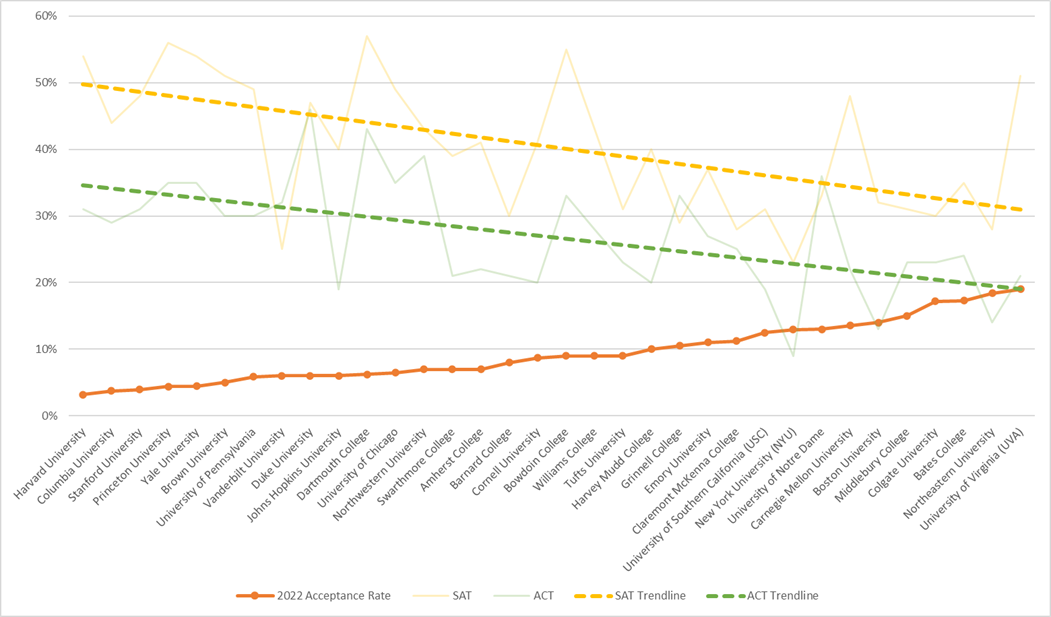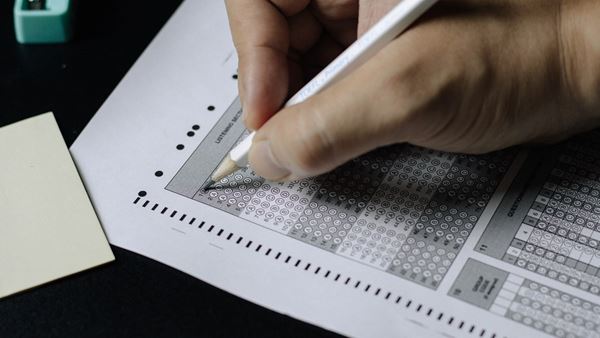Standardized Testing Policies in 2023
The landscape of standardized testing has shifted rapidly in the last few years, and we work with many students and families struggling to figure out what is the “correct” choice on how much to prioritize standardized tests, whether to submit the test scores received, or whether to take the tests at all.
This article shares an update on the current state of standardized testing policies, as well as some advice to help students and families make confident decisions around standardized testing.
Let’s start by making sense of the different types of standardized testing policies you may come across: It is hard to come by consistent data that shows the admit rate for students who submitted test scores versus those who did not. From the data we do have access to, we can ascertain that a sizable proportion of successful students did submit the SAT, ACT, or both. Note that there isn’t necessarily a causal relationship between a student sending in the score and their success in the process, but it is noteworthy, nonetheless. With some outliers, we can also see a trend that, as test-optional colleges get less selective, the rate of test score submission gradually declines.
In short, the data suggests that if a student is applying to highly selective colleges, while not essential, a strong test score could make for a helpful tool in their toolkit.
Our Advice
It is impossible to predict with certainty what individual colleges will decide around standardized testing in the future, but the dominant trend suggests that test-optional policies are here to stay. That said, our advice for most students is to put the effort into preparing for at least one best-foot-forward attempt at either the SAT or the ACT. We believe that having a test score, particularly one they feel represents them well, means they need not rule out any colleges just because they require testing.
Timing is also a key factor here: Does the student feel they can prepare for either the SAT or ACT effectively without it detracting from their schoolwork? For some students, that means completing their standardized testing prior to the fall of senior year.
Colleges will often report on their admissions websites the average SAT or ACT score for students who submitted their scores and were admitted. They may also report the mid-50% range test scores for those students. The mid-50% range consists of two numbers, for example, 1400-1500. This means that 25% of admitted students submitted test scores below a 1400, 50% of them scored between a 1400 and 1500, and 25% scored above a 1500.
When deciding whether to send in a score or not, we often recommend looking up a college’s mid-50% range for the prior year’s admitted students. If their score approaches the 75%th percentile or is higher than it, then a student can be quite confident that their score is going to be a plus in their application.
It is hard to come by consistent data that shows the admit rate for students who submitted test scores versus those who did not. From the data we do have access to, we can ascertain that a sizable proportion of successful students did submit the SAT, ACT, or both. Note that there isn’t necessarily a causal relationship between a student sending in the score and their success in the process, but it is noteworthy, nonetheless. With some outliers, we can also see a trend that, as test-optional colleges get less selective, the rate of test score submission gradually declines.
In short, the data suggests that if a student is applying to highly selective colleges, while not essential, a strong test score could make for a helpful tool in their toolkit.
Our Advice
It is impossible to predict with certainty what individual colleges will decide around standardized testing in the future, but the dominant trend suggests that test-optional policies are here to stay. That said, our advice for most students is to put the effort into preparing for at least one best-foot-forward attempt at either the SAT or the ACT. We believe that having a test score, particularly one they feel represents them well, means they need not rule out any colleges just because they require testing.
Timing is also a key factor here: Does the student feel they can prepare for either the SAT or ACT effectively without it detracting from their schoolwork? For some students, that means completing their standardized testing prior to the fall of senior year.
Colleges will often report on their admissions websites the average SAT or ACT score for students who submitted their scores and were admitted. They may also report the mid-50% range test scores for those students. The mid-50% range consists of two numbers, for example, 1400-1500. This means that 25% of admitted students submitted test scores below a 1400, 50% of them scored between a 1400 and 1500, and 25% scored above a 1500.
When deciding whether to send in a score or not, we often recommend looking up a college’s mid-50% range for the prior year’s admitted students. If their score approaches the 75%th percentile or is higher than it, then a student can be quite confident that their score is going to be a plus in their application.
- Testing required: This means that a college is requiring that the student submit an SAT or an ACT score as part of their application. Some examples of colleges that require testing for the upcoming admissions cycle include MIT, Georgetown, Purdue, the University of Florida, the University of Georgia, Georgia Tech, the U.S. Naval Academy, West Point, and the U.S. Air Force Academy.
- Test-free: Sometimes called “test-blind,” this means that a student does not have the option to send in a test score (even if they’d like to!) as it will not be considered as part of the admissions process. Some examples of test-free colleges include: The University of California and California State systems, Pitzer College, Worcester Polytechnic, and Reed College.
- Test-optional: The college gives students the choice of whether to submit a test score. The majority of colleges across all levels of selectivity are now test-optional. The website Fairtest.org hosts a frequently updated list of test-optional and test-free colleges. There are more than 1800 colleges that have said they will be test-optional or test-free for the fall of 2023.
 It is hard to come by consistent data that shows the admit rate for students who submitted test scores versus those who did not. From the data we do have access to, we can ascertain that a sizable proportion of successful students did submit the SAT, ACT, or both. Note that there isn’t necessarily a causal relationship between a student sending in the score and their success in the process, but it is noteworthy, nonetheless. With some outliers, we can also see a trend that, as test-optional colleges get less selective, the rate of test score submission gradually declines.
In short, the data suggests that if a student is applying to highly selective colleges, while not essential, a strong test score could make for a helpful tool in their toolkit.
Our Advice
It is impossible to predict with certainty what individual colleges will decide around standardized testing in the future, but the dominant trend suggests that test-optional policies are here to stay. That said, our advice for most students is to put the effort into preparing for at least one best-foot-forward attempt at either the SAT or the ACT. We believe that having a test score, particularly one they feel represents them well, means they need not rule out any colleges just because they require testing.
Timing is also a key factor here: Does the student feel they can prepare for either the SAT or ACT effectively without it detracting from their schoolwork? For some students, that means completing their standardized testing prior to the fall of senior year.
Colleges will often report on their admissions websites the average SAT or ACT score for students who submitted their scores and were admitted. They may also report the mid-50% range test scores for those students. The mid-50% range consists of two numbers, for example, 1400-1500. This means that 25% of admitted students submitted test scores below a 1400, 50% of them scored between a 1400 and 1500, and 25% scored above a 1500.
When deciding whether to send in a score or not, we often recommend looking up a college’s mid-50% range for the prior year’s admitted students. If their score approaches the 75%th percentile or is higher than it, then a student can be quite confident that their score is going to be a plus in their application.
It is hard to come by consistent data that shows the admit rate for students who submitted test scores versus those who did not. From the data we do have access to, we can ascertain that a sizable proportion of successful students did submit the SAT, ACT, or both. Note that there isn’t necessarily a causal relationship between a student sending in the score and their success in the process, but it is noteworthy, nonetheless. With some outliers, we can also see a trend that, as test-optional colleges get less selective, the rate of test score submission gradually declines.
In short, the data suggests that if a student is applying to highly selective colleges, while not essential, a strong test score could make for a helpful tool in their toolkit.
Our Advice
It is impossible to predict with certainty what individual colleges will decide around standardized testing in the future, but the dominant trend suggests that test-optional policies are here to stay. That said, our advice for most students is to put the effort into preparing for at least one best-foot-forward attempt at either the SAT or the ACT. We believe that having a test score, particularly one they feel represents them well, means they need not rule out any colleges just because they require testing.
Timing is also a key factor here: Does the student feel they can prepare for either the SAT or ACT effectively without it detracting from their schoolwork? For some students, that means completing their standardized testing prior to the fall of senior year.
Colleges will often report on their admissions websites the average SAT or ACT score for students who submitted their scores and were admitted. They may also report the mid-50% range test scores for those students. The mid-50% range consists of two numbers, for example, 1400-1500. This means that 25% of admitted students submitted test scores below a 1400, 50% of them scored between a 1400 and 1500, and 25% scored above a 1500.
When deciding whether to send in a score or not, we often recommend looking up a college’s mid-50% range for the prior year’s admitted students. If their score approaches the 75%th percentile or is higher than it, then a student can be quite confident that their score is going to be a plus in their application.






